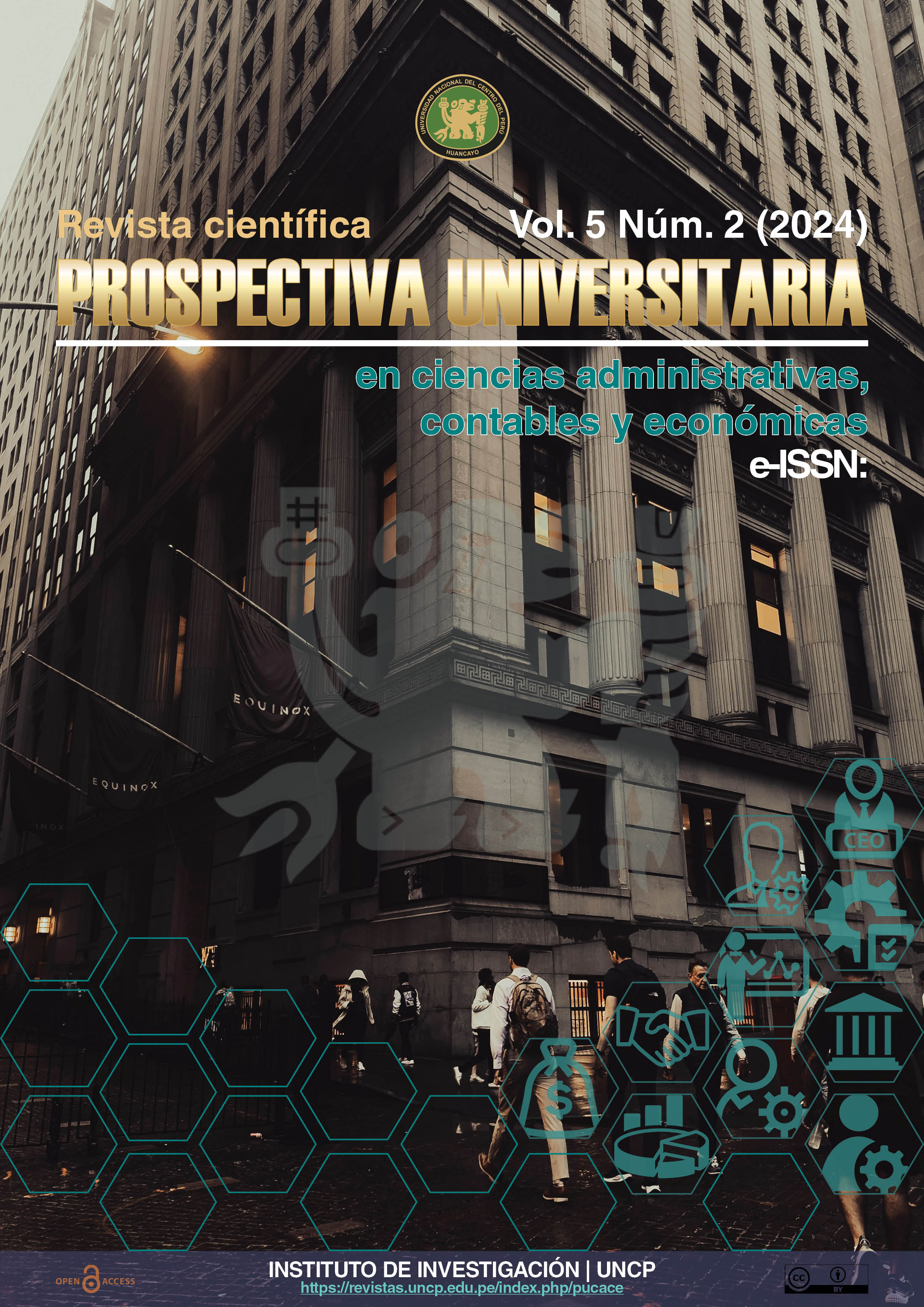Efectos de las competencias de los múltiples actores en la gestión de la reducción de la escasez del agua en la sub cuenca del río Shullcas, área metropolitana de Huancayo-Perú
Palabras clave:
gestión, recursos hídricos, escasez, aguaResumen
Was to determine the effects of the diversity of technical, financial, legal, social and environmental competencies of the multiple actors in the management of the reduction of water scarcity in the sub-basin of the Shullcas River, metropolitan area of Huancayo-Peru. (2) Methods: based on quasi-experiments, cross-sectional, semi-quantitative, which included population and intentional sample of 21 organizations, with competencies defined by law or statute or others, operationalized in surveys, interrelated in participatory models, cause-effect diagrams and fuzzy cognitive maps, supported by the mentalmodeler software. (3) Results: Of the total responses obtained, 25% specified social competencies, 22% environmental competencies, 20% technical competencies, 19% legal competencies, and 13% financial competencies, but did not reflect important actions in water scarcity reduction management (4%). (4) Conclusions: In the dynamics of the hypothetical scenarios, important effects were determined in the management of water scarcity reduction through strong favorable changes (+1) in the execution of the state variables of legal competencies, technical competencies, environmental competencies, financial competencies, and social competencies; with 40%, 35%, 35%, 30%, and 25% of state variables preferred in future scenarios respectively.
Referencias
Alvarez-Garreton, C., Boisier, J. P., Billi, M., Lefort, I., Marinao, R., & Barría, P. (2023). Protecting environmental flows to achieve long-term water security. Journal of Environmental Management, 328, 116914. https://doi.org/10.1016/j.jenvman.2022.116914
Alves, A., Gersonius, B., Sanchez, A., Vojinovic, Z., & Kapelan, Z. (2018). Multi-criteria Approach for Selection of Green and Grey Infrastructure to Reduce Flood Risk and Increase CO-benefits. Water Resources Management, 32(7), 2505-2522. https://doi.org/10.1007/s11269-018-1943-3
Alves, A., Vojinovic, Z., Kapelan, Z., Sanchez, A., & Gersonius, B. (2020). Exploring trade-offs among the multiple benefits of green-blue-grey infrastructure for urban flood mitigation. Science of The Total Environment, 703, 134980. https://doi.org/10.1016/j.scitotenv.2019.134980
Arana, F. (2021). Incidencia de la movilidad urbana en el crecimiento insostenible de la ciudad de Huancayo. Arquitectura y Urbanismo, XLII(3), 112-117.
Borràs, S., & Villavicencio, P. (2023). Vulnerabilidades climáticas y desplazamiento interno en España: Dos realidades complejas e interconectadas. Revista Catalana de Dret Ambiental, 14(1). https://doi.org/10.17345/rcda3587
Bureš, V. (2017). A Method for Simplification of Complex Group Causal Loop Diagrams Based on Endogenisation, Encapsulation and Order-Oriented Reduction. Systems, 5(3), 46. https://doi.org/10.3390/systems5030046
Castro, C. V. (2022). Systems-thinking for environmental policy coherence: Stakeholder knowledge, fuzzy logic, and causal reasoning. Environmental Science & Policy, 136, 413-427. https://doi.org/10.1016/j.envsci.2022.07.001
Coletta, V. R., Pagano, A., Pluchinotta, I., Fratino, U., Scrieciu, A., Nanu, F., & Giordano, R. (2021). Causal Loop Diagrams for supporting Nature Based Solutions participatory design and performance assessment. Journal of Environmental Management, 280, 111668. https://doi.org/10.1016/j.jenvman.2020.111668
De Miguel, F. M. (2006). Metodologías de enseñanzas y aprendizaje para el desarrollo de competencias: Orientaciones para el profesorado universitario ante el espacio europeo de educación superior. Alianza. https://dialnet.unirioja.es/servlet/libro?codigo=293088
Desbureaux, S., & Rodella, A.-S. (2019). Drought in the city: The economic impact of water scarcity in Latin American metropolitan areas. World Development, 114, 13-27. https://doi.org/10.1016/j.worlddev.2018.09.026
Faivre, N., Fritz, M., Freitas, T., De Boissezon, B., & Vandewoestijne, S. (2017). Nature-Based Solutions in the EU: Innovating with nature to address social, economic and environmental challenges. Environmental Research, 159, 509-518. https://doi.org/10.1016/j.envres.2017.08.032
Giordano, R., & Liersch, S. (2012). A fuzzy GIS-based system to integrate local and technical knowledge in soil salinity monitoring. Environmental Modelling & Software, 36, 49-63. https://doi.org/10.1016/j.envsoft.2011.09.004
Gray, S. A., Gray, S., Cox, L. J., & Henly-Shepard, S. (2013). Mental Modeler: A Fuzzy-Logic Cognitive Mapping Modeling Tool for Adaptive Environmental Management. 2013 46th Hawaii International Conference on System Sciences, 965-973. https://doi.org/10.1109/HICSS.2013.399
Gray, S. A., Gray, S., De Kok, J. L., Helfgott, A. E. R., O’Dwyer, B., Jordan, R., & Nyaki, A. (2015). Using fuzzy cognitive mapping as a participatory approach to analyze change, preferred states, and perceived resilience of social-ecological systems. Ecology and Society, 20(2), art11. https://doi.org/10.5751/ES-07396-200211
Inam, A., Adamowski, J., Halbe, J., & Prasher, S. (2015). Using causal loop diagrams for the initialization of stakeholder engagement in soil salinity management in agricultural watersheds in developing countries: A case study in the Rechna Doab watershed, Pakistan. Journal of Environmental Management, 152, 251-267. https://doi.org/10.1016/j.jenvman.2015.01.052
Jetter, A., & Schweinfort, W. (2011). Building scenarios with Fuzzy Cognitive Maps: An exploratory study of solar energy. Futures, 43(1), 52-66. https://doi.org/10.1016/j.futures.2010.05.002
Jha, A. K., Bloch, R., & Lamond, J. (2012). Cities and Flooding: A Guide to Integrated Urban Flood Risk Management for the 21st Century. The World Bank. https://doi.org/10.1596/978-0-8213-8866-2
Jones, N. A., Ross, H., Lynam, T., Perez, P., & Leitch, A. (2011). Mental Models: An Interdisciplinary Synthesis of Theory and Methods. Ecology and Society, 16(1), art46. https://doi.org/10.5751/ES-03802-160146
Keesstra, S., Nunes, J., Novara, A., Finger, D., Avelar, D., Kalantari, Z., & Cerdà, A. (2018). The superior effect of nature based solutions in land management for enhancing ecosystem services. Science of The Total Environment, 610-611, 997-1009. https://doi.org/10.1016/j.scitotenv.2017.08.077
McGill, B. M., Altchenko, Y., Hamilton, S. K., Kenabatho, P. K., Sylvester, S. R., & Villholth, K. G. (2019). Complex interactions between climate change, sanitation, and groundwater quality: A case study from Ramotswa, Botswana. Hydrogeology Journal, 27(3), 997-1015. https://doi.org/10.1007/s10040-018-1901-4
Oppliger, A., Höhl, J., & Fragkou, M. (2019). Escasez de agua: Develando sus orígenes híbridos en la cuenca del Río Bueno, Chile. Revista de Geografía Norte Grande, 73, 9-27. https://doi.org/10.4067/S0718-34022019000200009
Qin, G., Meng, Z., & Fu, Y. (2022). Drought and water-use efficiency are dominant environmental factors affecting greenness in the Yellow River Basin, China. Science of The Total Environment, 834, 155479. https://doi.org/10.1016/j.scitotenv.2022.155479
Sterman, J. D. (2001). System Dynamics Modeling: Tools for Learning in a Complex World. California Management Review, 43(4), 8-25. https://doi.org/10.2307/41166098
Tiwary, A., & Kumar, P. (2014). Impact evaluation of green–grey infrastructure interaction on built-space integrity: An emerging perspective to urban ecosystem service. Science of The Total Environment, 487, 350-360. https://doi.org/10.1016/j.scitotenv.2014.03.032
Descargas
Publicado
Número
Sección
Licencia
Derechos de autor 2024 Victor Bullón García, Socorro Jackelin Bullón Mallqui, Katherine Stefanie Romero Vargas

Esta obra está bajo una licencia internacional Creative Commons Atribución 4.0.
![IconJournalPUCACE [ESP] by Edgar Julian-Laime®](https://revistas.uncp.edu.pe/public/journals/31/pageHeaderLogoImage_es.png)






